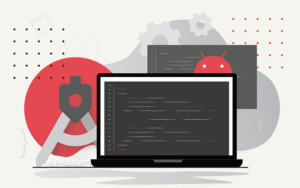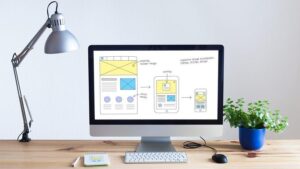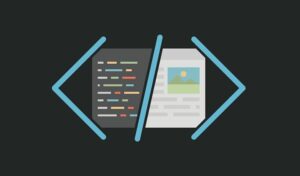Android Programming or Web Design?
Android programming and web design are both great career options. Which one is better for you? Many programmers find that one area of software design aligns more with their interests and career aspirations as they learn.
This post will explore the main differences between Android programming and web design in terms of career paths, salaries, learning requirements, and more so you know where to start learning.
Overall Comparison of Android Programming and Web Design
- Android programmers develop mobile applications for the Android platform.
- Web designers create web applications that are accessible in web browsers.
- Many web designers find it easier to learn front-end design than Android.
- Android and web developers can work in public and private companies or as freelancers.
- There is a strong long-term job outlook for Android and web designers.
Web design and Android programming require different skills, have other markets, and have diverse applications. When choosing, we should compare them based on the frameworks needed to learn web design and Android, the difficulty level, job opportunities, salaries, and future trends.
Below, we will define Android programming and web design and then compare them based on all the necessary parameters to choose the right career option for you. You can start your career in programming by learning programming online through the educational services section of Karlenser.
What is Android programming?
Android programming means creating applications for the Android operating system. Google made this open-source mobile operating system, which runs on phones, tablets, smartwatches, TVs, and many other devices. Android is the most popular smartphone operating system, with over 2 billion users worldwide.

Many novice programmers find learning Android more complex than front-end design but also very rewarding. Once Android programmers learn the unique aspects of Android app design (such as working with the Android SDK), their job becomes much easier. Since Android is open source and widely used, it has a large global community that is useful for starting to learn.
The demand for hiring Android developers continues to grow along with the growth of the Android platform and the increase in smartphone usage. Since Android is more difficult to learn, there is less competition for hiring experienced Android developers.
Key Aspects of Android Programming
Android developers are responsible for designing and building Android apps, which are typically used for publishing on the Google Play Store. This process involves writing Java or Kotlin code that uses various features of the Android SDK to create an Android app. Most programming is done in Android Studio, an integrated development environment (IDE) with essential tools for writing and debugging code.
Android developers also write code that interacts with APIs and databases to share and store information with back-end or third-party systems. This process allows developers to integrate more advanced features, such as account management or payment processing, into their Android apps, which would be challenging to include in the software package.
Some mobile developers also choose to learn iOS programming to build apps for both major mobile platforms. Since it is challenging to have deep expertise in developing native apps for both Android and iOS, some development teams choose to use a cross-platform mobile framework such as Flutter or React Native. This cross-platform approach is growing in popularity but requires a very different skill set than Android programming.
Android Programming Career Opportunities
There are various ways to apply an Android developer’s skills. More experienced developers may want to work for themselves as freelancers, but most beginners will likely start their careers by working for a company.

You can work for a small startup that makes mobile games or for a large software company as an Android app developer as part of a larger project designing apps for employees or clients. Mobile apps are growing in popularity in almost every industry—from gaming and financial services to healthcare and retail—so there are various job opportunities.
Many companies (especially small to medium-sized ones) lack the resources to hire an in-house development team. Instead, they outsource the work to a specialized app development company or freelance app designer. Working for a company or as a freelancer allows Android developers to gain experience developing various apps in a shorter period.
Knowledge Required for Android Programming
Here are some of the basic skills a beginner Android developer should learn:
- Java programming (and increasingly Kotlin)
- XML (Extensible Markup Language)
- Using the Android Studio IDE (Integrated Development Environment)
- Working with the Android SDK (Software Development Kit)
- Basic Android UI design skills
- Communicating with APIs
- Working with databases
What is web design?
Web design involves building websites and web applications accessible on the internet through web browsers, but there are a few different areas for web developers.
Front-end developers focus on the web user or PWA. They require knowledge of HTML, CSS, and JavaScript to bring mockups or wireframes to life. Most front-end developers are interested in designing great user experiences.

Back-end developers work with databases and servers to manage a website’s more complex functions. This requires knowledge of a back-end programming language like Java, Python, Ruby, or JavaScript. Back-end developers must also be familiar with building APIs, interacting with database management systems, and maintaining servers.
Full-stack developers are skilled in front-end and back-end development, giving them a more comprehensive understanding of the web application development process. As such, full-stack development is currently one of the most in-demand web design jobs.
Key Aspects of Web Design
Web designers have a variety of career paths, but each role has a common goal: building a user-friendly website or web application. The specific area you specialize in will depend on your talents and interests. Front-end developers are generally more creative and focused on design, while back-end developers enjoy solving complex problems and working with data.
Web Design Career Opportunities
Like Android developers, web developers can offer their skills as freelancers or work for a company. Almost every company has at least one website, and many larger companies are launching web applications with more advanced features, so the job opportunities are almost limitless.

Knowledge required for website design
Front-end designer:
- HTML
- CSS
- JavaScript
- API communication (application programming interface)
- Front-end web frameworks such as JS or React.js
- Cross-browser optimization
- Knowledge of user experience (UX) design for websites or web applications
Back-end designer:
- Programming skills with a supporting language (Python, Java, PHP or JavaScript)
- Building and maintaining APIs
- Back-end frameworks such as Flask or Django
- SQL (Structured Search Language)
- Familiarity with database management systems
- Standard algorithms and data structures
- Basic server administration

Steps to learn website design and Android programming
Website design
Step 1: Choose your area of interest from front-end, back-end, or full stack.
Step 2: Front-end developers should learn the required skills, such as:
- Designing using HTML
- Styling a web page using various properties in CSS (Cascading Style Sheet)
- How JavaScript fetches queries, responds to them, and helps add interactive features such as sound, video, and images
- Responsive designs that help web pages adjust to the device (Bootstrap)
- Version control systems such as Git and GitHub should also be used, as they allow tracking of changes made and reverting to previous versions.
If you are interested in back-end development, you can learn the following:
- Programming languages like Java or Python,
- Server-side frameworks like Node JS
- SQL and NoSQL database systems like MYSQL and MongoDB, where data is stored, retrieved, and updated.
Step 3: You should know HTTP protocols and deployment tools to transfer files and data to and from the server.
Learning DevOps is great because it helps a team implement the entire application development lifecycle.

Android Programming
Step 1: Learn the basics of Android development, which includes
- Java SDK
- Familiarity with any programming language, including Java or Kotlin
- Android UI Design
Step 2: Learn advanced Android development skills, which includes
- Proficient in using Git, REST API
- Understanding database systems
- Designing applications around UI, Cloud Messaging API, and Continuous Integration
Difficulty level of learning programming
Front-end website design is easier than back-end website design because, in the back-end, you also have to keep track of the processed data in addition to storing and maintaining data. Overall, web design is more straightforward than Android. However, this largely depends on the project you are building. For example, designing a web page using HTML and CSS is easier than creating a basic Android app.
Job Opportunities for Android Programming vs Web Design
The global mobile app development market is likely to grow at 14%. Similarly, job opportunities for web designers are expected to grow by 25-27% by 2024. So, the job market for both technologies is constantly increasing. But since learning web design is relatively easier than learning Android programming, the competition among web designers is very high! On the other hand, the number of Android developers is relatively less than that of web designers, so the demand for their employment is slightly higher. Overall, developers skilled in Android and web development will be in the highest demand as many more job opportunities are emerging for them in both fields.
Learning Curve of Programming and Design
Both web design and Android development are significant and impressive skills. Web design teaches us languages like HTML, CSS, JavaScript, ReactJS, AngularJS, and server-side frameworks like NodeJS. In mobile app design, you can learn iOS and Android app design. Here, you can learn and implement programming languages like Java, Kotlin, etc. Learning Git and GitHub and database management systems are a common requirement in any software development process.

Salary and Future Development
Salary is one important criterion when deciding on career options. Depending on experience and expertise, different salaries are paid. iOS developers’ salaries are slightly higher than Android developers’ because the number of skilled iOS developers is less compared to Android developers. Android developers can launch their own Android apps independently, which can be a very lucrative option.
The average salary of front-end developers is slightly lower than that of back-end developers, indicating a higher level of expertise in back-end development. However, salaries can vary greatly depending on location, experience, role, and other factors.
Finally
As technology advances daily, both web designers and Android developers have a bright future ahead of them. The demand for good, user-friendly mobile and web applications is constantly increasing, and it’s not stopping anytime soon!
Resources
https://blog.teamtreehouse.com/android-developer-vs-web-developer
https://www.geeksforgeeks.org/web-developer-or-android-developer-which-one-is-better-career-choice